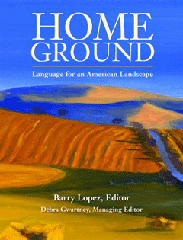The Language of Landscape
Air Date: Week of June 19, 2009

Living on Earth continues its series exploring features of the American landscape. It’s based on the book “Home Ground: Language for an American Landscape,” edited by Barry Lopez and Debra Gwartney. In this installment, Pattiann Rogers explains the wetlands term tule.
Transcript
Just ahead– a blue way to fight the war on drugs– but first, we step into our occasional series, Home Ground.
[MUSIC: Boards Of Canada “Zoetrope” from “In A Beautiful Place Out In The Country” (Warp Records 2000)]
CURWOOD: Landscape exerts a hold on many of us – those blue remembered hills, the scent of that swamp, the folds of the valleys. The very names of our country’s features stir emotions. Some of its unique places are described in the book “Home Ground: Language for an American Landscape”, compiled by Barry Lopez and Debra Gwartney.
Today, poet Pattiann Rogers reads her description of “tule”.
ROGERS: Tule derives from the Aztec tullin or tollin, meaning any of several wetland plants, specifically bulrushes. The tules are marshy, swampy wilderness regions in California where these grasslike perennial herbs, cattails, bulrushes, and sedges are prevalent and may reach heights of fifteen to twenty feet. Tule has given its name to the small California elk, the tule elk, once nearly extinct, and to a population of the California marsh wren, the tule wren. Because of the thick, harsh wildness of the tule areas, “to be deep in the tules” means to be in trouble. “To pull freight for the tules” means to run from the law. In An Apostle of the Tules, Bret Harte describes the tules in Tassajara Valley, California, this way: “A more barren, dreary, monotonous and uninviting landscape never stretched before human eye…the breath of the haunted tules in the outlying Stockton marshes swept through the valley.”
CURWOOD: Poet Pattiann Rogers lives in Colorado. Her definition of “tule” comes from “Home Ground: Language for an American Landscape”, edited by Barry Lopez and Debra Gwartney.
Links
Living on Earth wants to hear from you!
Living on Earth
62 Calef Highway, Suite 212
Lee, NH 03861
Telephone: 617-287-4121
E-mail: comments@loe.org
Newsletter [Click here]
Donate to Living on Earth!
Living on Earth is an independent media program and relies entirely on contributions from listeners and institutions supporting public service. Please donate now to preserve an independent environmental voice.
NewsletterLiving on Earth offers a weekly delivery of the show's rundown to your mailbox. Sign up for our newsletter today!
 Sailors For The Sea: Be the change you want to sea.
Sailors For The Sea: Be the change you want to sea.
 The Grantham Foundation for the Protection of the Environment: Committed to protecting and improving the health of the global environment.
The Grantham Foundation for the Protection of the Environment: Committed to protecting and improving the health of the global environment.
 Contribute to Living on Earth and receive, as our gift to you, an archival print of one of Mark Seth Lender's extraordinary wildlife photographs. Follow the link to see Mark's current collection of photographs.
Contribute to Living on Earth and receive, as our gift to you, an archival print of one of Mark Seth Lender's extraordinary wildlife photographs. Follow the link to see Mark's current collection of photographs.
 Buy a signed copy of Mark Seth Lender's book Smeagull the Seagull & support Living on Earth
Buy a signed copy of Mark Seth Lender's book Smeagull the Seagull & support Living on Earth

